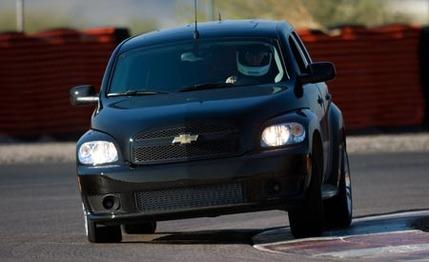 First Drive Review
First Drive Review
We had a Twilight Zone sort of distorted-reality moment on our recent drive of Chevrolet's new HHR SS when one of the engineers on the project compared the retro trucklet with the Mazdaspeed 3. Who would have ever thought we'd be comparing an HHR with that angry little hatch? Pricing for the SS will start right around the Mazdaspeed 3's $22,935 base, and dimensionally, the match-up makes sense. The Mazda is less than an inch longer and the HHR 4.8 inches taller (HHR does, after all, stand for Heritage High Roof), but comparing the two still seems a little like dropping a kitten into a terrarium with a scorpion.
Don't be misled, though, because in the all-important power-to-weight-ratio battle, the HHR proves it has some venom on tap. The last Mazdaspeed 3 we tested weighed 3202 pounds; the HHR SS weighs an estimated 3300. Although the Mazdaspeed packs 263 ponies from its turbocharged 2.3-liter, the SS's turbocharged four—the same as found in the Pontiac Solstice GXP, Saturn Sky Red Line, and upcoming Chevy Cobalt SS—manages 260 horsepower from its two liters, yielding 12.7 pounds per horsepower, which is within nipping distance of the Mazdaspeed 3's 12.2.
It Might Be Cute, but It Can Get a Little Nasty
For those who are still skeptical, consider that the HHR SS includes some pretty nifty performance tuning tricks such as launch control. With the standard StabiliTrak control in competitive mode, the engine is limited to 4100 rpm until the tires hook up. In cars with the manual transmission, flooring the accelerator with the clutch depressed holds the engine at 4100 rpm. Miscreants who need more freedom to smoke the front tires will be happy to hear that, with stability control fully off, redline-wrenching parking-brake burnouts are still a possibility. Torque steer, a virtual guarantee when plumbing 260 pound-feet of torque through the front wheels, is wonderfully minimized; we noticed just the tiniest whiff in the lower gears.
The second bit of surprising high-performance programming in the HHR SS is the no-lift shift feature, which allows the driver to keep the throttle pinned during shifts and holds the engine just below redline, therefore keeping boost up and eliminating turbo lag. With the throttle on the floor, the unrelenting turbo whoosh from beneath the HHR's shapely hood is accompanied by a pleasingly violent pop from the exhaust pipe during shifts.
The launch control and the no-lift shifting are rather hard-core for such a mild-mannered bread van, but then again, so are the performance figures. Chevy says 60 mph will arrive in 6.3 seconds and the quarter-mile in 14.8 seconds at 99 mph, numbers that would have trailed the field in our most recent hot-hatch comparo by only the smallest of margins. Just as important, the company claims 0.86 g on the skidpad, a scant 0.01 g behind the Mazdaspeed 3.
Numbers are one thing—tie enough bottle rockets to a can of rotten tuna fish and it'll go fast. Feel is something much harder to accomplish, and we are pleased to report that the fun of the HHR SS driving experience goes well beyond engaging launch control and tromping on the gas pedal.